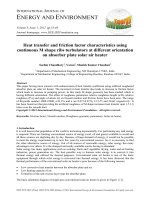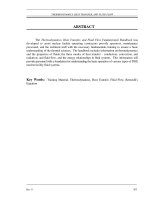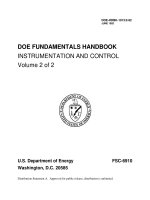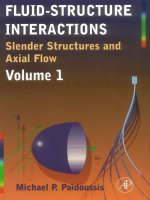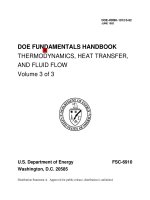- Trang chủ >>
- Khoa Học Tự Nhiên >>
- Vật lý
doe fundamentals handbook - thermodynamics, heat transfer, and fluid flow - volume 2 of 3
Bạn đang xem bản rút gọn của tài liệu. Xem và tải ngay bản đầy đủ của tài liệu tại đây (1.16 MB, 80 trang )
DOE-HDBK-1012/2-92
JUNE 1992
DOE FUNDAMENTALS HANDBOOK
THERMODYNAMICS, HEAT TRANSFER,
AND FLUID FLOW
Volume 2 of 3
U.S. Department of Energy FSC-6910
Washington, D.C. 20585
Distribution Statement A. Approved for public release; distribution is unlimited.
This document has been reproduced directly from the best available copy.
Available to DOE and DOE contractors from the Office of Scientific and Technical
Information. P. O. Box 62, Oak Ridge, TN 37831; prices available from (615) 576-
8401. FTS 626-8401.
Available to the public from the National Technical Information Service, U.S.
Department of Commerce, 5285 Port Royal Rd., Springfield, VA 22161.
Order No. DE92019790
THERMODYNAMICS, HEAT TRANSFER, AND FLUID FLOW
Rev. 0 HT
ABSTRACT
The Thermodynamics, Heat Transfer, and Fluid Flow Fundamentals Handbook was
developed to assist nuclear facility operating contractors provide operators, maintenance
personnel, and the technical staff with the necessary fundamentals training to ensure a basic
understanding of the thermal sciences. The handbook includes information on thermodynamics
and the properties of fluids; the three modes of heat transfer - conduction, convection, and
radiation; and fluid flow, and the energy relationships in fluid systems. This information will
provide personnel with a foundation for understanding the basic operation of various types of DOE
nuclear facility fluid systems.
Key Words: Training Material, Thermodynamics, Heat Transfer, Fluid Flow, Bernoulli's
Equation
THERMODYNAMICS, HEAT TRANSFER, AND FLUID FLOW
Rev. 0 HT
FOREWORD
The Department of Energy (DOE) Fundamentals Handbooks consist of ten academic
subjects, which include Mathematics; Classical Physics; Thermodynamics, Heat Transfer, and Fluid
Flow; Instrumentation and Control; Electrical Science; Material Science; Mechanical Science;
Chemistry; Engineering Symbology, Prints, and Drawings; and Nuclear Physics and Reactor
Theory. The handbooks are provided as an aid to DOE nuclear facility contractors.
These handbooks were first published as Reactor Operator Fundamentals Manuals in 1985
for use by DOE Category A reactors. The subject areas, subject matter content, and level of detail
of the Reactor Operator Fundamentals Manuals was determined from several sources. DOE
Category A reactor training managers determined which materials should be included, and served
as a primary reference in the initial development phase. Training guidelines from the commercial
nuclear power industry, results of job and task analyses, and independent input from contractors
and operations-oriented personnel were all considered and included to some degree in developing
the text material and learning objectives.
The DOE Fundamentals Handbooks represent the needs of various DOE nuclear facilities'
fundamentals training requirements. To increase their applicability to nonreactor nuclear facilities,
the Reactor Operator Fundamentals Manual learning objectives were distributed to the Nuclear
Facility Training Coordination Program Steering Committee for review and comment. To update
their reactor-specific content, DOE Category A reactor training managers also reviewed and
commented on the content. On the basis of feedback from these sources, information that applied
to two or more DOE nuclear facilities was considered generic and was included. The final draft
of each of these handbooks was then reviewed by these two groups. This approach has resulted
in revised modular handbooks that contain sufficient detail such that each facility may adjust the
content to fit their specific needs.
Each handbook contains an abstract, a foreword, an overview, learning objectives, and text
material, and is divided into modules so that content and order may be modified by individual DOE
contractors to suit their specific training needs. Each subject area is supported by a separate
examination bank with an answer key.
The DOE Fundamentals Handbooks have been prepared for the Assistant Secretary for
Nuclear Energy, Office of Nuclear Safety Policy and Standards, by the DOE Training Coordination
Program. This program is managed by EG&G Idaho, Inc.
THERMODYNAMICS, HEAT TRANSFER, AND FLUID FLOW
Rev. 0 HT
OVERVIEW
The Department of Energy Fundamentals Handbook entitled Thermodynamics, Heat
Transfer, and Fluid Flow was prepared as an information resource for personnel who are
responsible for the operation of the Department's nuclear facilities. A basic understanding of the
thermal sciences is necessary for DOE nuclear facility operators, maintenance personnel, and the
technical staff to safely operate and maintain the facility and facility support systems. The
information in the handbook is presented to provide a foundation for applying engineering
concepts to the job. This knowledge will help personnel more fully understand the impact that
their actions may have on the safe and reliable operation of facility components and systems.
The Thermodynamics, Heat Transfer, and Fluid Flow handbook consists of three modules
that are contained in three volumes. The following is a brief description of the information
presented in each module of the handbook.
Volume 1 of 3
Module 1 - Thermodynamics
This module explains the properties of fluids and how those properties are
affected by various processes. The module also explains how energy balances can
be performed on facility systems or components and how efficiency can be
calculated.
Volume 2 of 3
Module 2 - Heat Transfer
This module describes conduction, convection, and radiation heat transfer. The
module also explains how specific parameters can affect the rate of heat transfer.
Volume 3 of 3
Module 3 - Fluid Flow
This module describes the relationship between the different types of energy in a
fluid stream through the use of Bernoulli's equation. The module also discusses
the causes of head loss in fluid systems and what factors affect head loss.
THERMODYNAMICS, HEAT TRANSFER, AND FLUID FLOW
Rev. 0 HT
The information contained in this handbook is by no means all encompassing. An
attempt to present the entire subject of thermodynamics, heat transfer, and fluid flow would be
impractical. However, the Thermodynamics, Heat Transfer, and Fluid Flow handbook does
present enough information to provide the reader with a fundamental knowledge level sufficient
to understand the advanced theoretical concepts presented in other subject areas, and to better
understand basic system and equipment operations.
Department of Energy
Fundamentals Handbook
THERMODYNAMICS,THERMODYNAMICS, HEATHEAT TRANSFER,TRANSFER,
ANDAND FLUIDFLUID FLOW,FLOW,
ModuleModule 22
HeatHeat TransferTransfer
Heat Transfer TABLE OF CONTENTS
TABLE OF CONTENTS
LIST OF FIGURES iii
LIST OF TABLES iv
REFERENCES v
OBJECTIVES vii
HEAT TRANSFER TERMINOLOGY 1
Heat and Temperature 1
Heat and Work 2
Modes of Transferring Heat 2
Heat Flux 3
Thermal Conductivity 3
Log Mean Temperature Difference 3
Convective Heat Transfer Coefficient 4
Overall Heat Transfer Coefficient 4
Bulk Temperature 4
Summary 5
CONDUCTION HEAT TRANSFER 6
Conduction 6
Conduction-Rectangular Coordinates 7
Equivalent Resistance Method 9
Electrical Analogy 10
Conduction-Cylindrical Coordinates 11
Summary 17
CONVECTION HEAT TRANSFER 18
Convection 18
Overall Heat Transfer Coefficient 20
Convection Heat Transfer 23
Summary 25
RADIANT HEAT TRANSFER 26
Thermal Radiation 26
Black Body Radiation 26
Emissivity 27
Rev. 0 Page i HT-02
TABLE OF CONTENTS Heat Transfer
HT-02 Page ii Rev. 0
TABLE OF CONTENTS (Cont.)
Radiation Configuration Factor 27
Summary 29
HEAT EXCHANGERS 30
Heat Exchangers 30
Parallel and Counter-Flow Designs 31
Non-Regenerative Heat Exchanger 34
Regenerative Heat Exchanger 34
Cooling Towers 35
Log Mean Temperature Difference Application to Heat Exchangers 36
Overall Heat Transfer Coefficient 37
Summary 39
BOILING HEAT TRANSFER 40
Boiling 40
Nucleate Boiling 40
Bulk Boiling 41
Film Boiling 41
Departure from Nucleate Boiling and Critical Heat Flux 42
Summary 43
HEAT GENERATION 44
Heat Generation 44
Flux Profiles 46
Thermal Limits 47
Average Linear Power Density 47
Maximum Local Linear Power Density 48
Temperature Profiles 48
Volumetric Thermal Source Strength 50
Fuel Changes During Reactor Operation 50
Summary 51
DECAY HEAT 52
Reactor Decay Heat Production 52
Calculation of Decay heat 53
Decay Heat Limits 55
Decay Heat Removal 56
Summary 57
Heat Transfer LIST OF FIGURES
Rev. 0 Page iii HT-02
LIST OF FIGURES
Figure 1 Conduction Through a Slab 7
Figure 2 Equivalent Resistance 10
Figure 3 Cross-sectional Surface Area of a Cylindrical Pipe 11
Figure 4 Composite Cylindrical Layers 15
Figure 5 Pipe Insulation Problem 16
Figure 6 Overall Heat Transfer Coefficient 20
Figure 7 Combined Heat Transfer 21
Figure 8 Typical Tube and Shell Heat Exchanger 31
Figure 9 Fluid Flow Direction 32
Figure 10 Heat Exchanger Temperature Profiles 33
Figure 11 Non-Regenerative Heat Exchanger 34
Figure 12 Regenerative Heat Exchanger 35
Figure 13 Boiling Heat Transfer Curve 42
Figure 14 Axial Flux Profile 46
Figure 15 Radial Flux Profile 46
Figure 16 Axial Temperature Profile 48
Figure 17 Radial Temperature Profile Across a Fuel Rod and
Coolant Channel 49
LIST OF TABLES Heat Transfer
LIST OF TABLES
NONE
HT-02 Page iv Rev. 0
Heat Transfer REFERENCES
REFERENCES
VanWylen, G. J. and Sonntag, R. E., Fundamentals of Classical Thermodynamics
SI Version, 2nd Edition, John Wiley and Sons, New York, ISBN 0-471-04188-2.
Kreith, Frank, Principles of Heat Transfer, 3rd Edition, Intext Press, Inc., New
York, ISBN 0-7002-2422-X.
Holman, J. P., Thermodynamics, McGraw-Hill, New York.
Streeter, Victor, L., Fluid Mechanics, 5th Edition, McGraw-Hill, New York, ISBN
07-062191-9.
Rynolds, W. C. and Perkins, H. C., Engineering Thermodynamics, 2nd Edition,
McGraw-Hill, New York, ISBN 0-07-052046-1.
Meriam, J. L., Engineering Mechanics Statics and Dynamics, John Wiley and
Sons, New York, ISBN 0-471-01979-8.
Schneider, P. J. Conduction Heat Transfer, Addison-Wesley Pub. Co., California.
Holman, J. P., Heat Transfer, 3rd Edition, McGraw-Hill, New York.
Knudsen, J. G. and Katz, D. L., Fluid Dynamics and Heat Transfer, McGraw-Hill,
New York.
Kays, W. and London, A. L., Compact Heat Exchangers, 2nd Edition, McGraw-
Hill, New York.
Weibelt, J. A., Engineering Radiation Heat Transfer, Holt, Rinehart and Winston
Publish., New York.
Sparrow, E. M. and Cess, R. E., Radiation Heat Transfer, Brooks/Cole Publish.
Co., Belmont, California.
Hamilton, D. C. and Morgan, N. R., Radiant-Interchange Configuration Factors,
Tech. Note 2836, National Advisory Committee for Aeronautics.
McDonald, A. T. and Fox, R. W., Introduction to Fluid mechanics, 2nd Edition,
John Wiley and Sons, New York, ISBN 0-471-01909-7.
Rev. 0 Page v HT-02
REFERENCES Heat Transfer
REFERENCES (Cont.)
Zucrow, M. J. and Hoffman, J. D., Gas Dynamics Vol.b1, John Wiley and Sons,
New York, ISBN 0-471-98440-X.
Crane Company, Flow of Fluids Through Valves, Fittings, and Pipe, Crane Co.
Technical Paper No. 410, Chicago, Illinois, 1957.
Esposito, Anthony, Fluid Power with Applications, Prentice-Hall, Inc., New
Jersey, ISBN 0-13-322701-4.
Beckwith, T. G. and Buck, N. L., Mechanical Measurements, Addison-Wesley
Publish Co., California.
Wallis, Graham, One-Dimensional Two-Phase Flow, McGraw-Hill, New York,
1969.
Kays, W. and Crawford, M. E., Convective Heat and Mass Transfer, McGraw-
Hill, New York, ISBN 0-07-03345-9.
Collier, J. G., Convective Boiling and Condensation, McGraw-Hill, New York,
ISBN 07-084402-X.
Academic Program for Nuclear Power Plant Personnel, Volumes III and IV,
Columbia, MD: General Physics Corporation, Library of Congress Card #A
326517, 1982.
Faires, Virgel Moring and Simmang, Clifford Max, Thermodynamics, MacMillan
Publishing Co. Inc., New York.
HT-02 Page vi Rev. 0
Heat Transfer OBJECTIVES
TERMINAL OBJECTIVE
1.0 Given the operating conditions of a thermodynamic system and the necessary
formulas, EVALUATE the heat transfer processes which are occurring.
ENABLING OBJECTIVES
1.1 DESCRIBE the difference between heat and temperature.
1.2 DESCRIBE the difference between heat and work.
1.3 DESCRIBE the Second Law of Thermodynamics and how it relates to heat transfer.
1.4 DESCRIBE the three modes of heat transfer.
1.5 DEFINE the following terms as they relate to heat transfer:
a. Heat flux
b. Thermal conductivity
c. Log mean temperature difference
d. Convective heat transfer coefficient
e. Overall heat transfer coefficient
f. Bulk temperature
1.6 Given Fourier’s Law of Conduction, CALCULATE the conduction heat flux in a
rectangular coordinate system.
1.7 Given the formula and the necessary values, CALCULATE the equivalent thermal
resistance.
1.8 Given Fourier’s Law of Conduction, CALCULATE the conduction heat flux in a
cylindrical coordinate system.
1.9 Given the formula for heat transfer and the operating conditions of the system,
CALCULATE the rate of heat transfer by convection.
1.10 DESCRIBE how the following terms relate to radiant heat transfer:
a. Black body radiation
b. Emissivity
c. Radiation configuration factor
Rev. 0 Page vii HT-02
OBJECTIVES Heat Transfer
ENABLING OBJECTIVES (Cont.)
1.11 DESCRIBE the difference in the temperature profiles for counter-flow and parallel flow
heat exchangers.
1.12 DESCRIBE the differences between regenerative and non-regenerative heat exchangers.
1.13 Given the temperature changes across a heat exchanger, CALCULATE the log mean
temperature difference for the heat exchanger.
1.14 Given the formulas for calculating the conduction and convection heat transfer
coefficients, CALCULATE the overall heat transfer coefficient of a system.
1.15 DESCRIBE the process that occurs in the following regions of the boiling heat transfer
curve:
a. Nucleate boiling
b. Partial film boiling
c. Film boiling
d. Departure from nucleate boiling (DNB)
e. Critical heat flux
HT-02 Page viii Rev. 0
Heat Transfer OBJECTIVES
TERMINAL OBJECTIVE
2.0 Given the operating conditions of a typical nuclear reactor, DESCRIBE the heat transfer
processes which are occurring.
ENABLING OBJECTIVES
2.1 DESCRIBE the power generation process in a nuclear reactor core and the factors that
affect the power generation.
2.2 DESCRIBE the relationship between temperature, flow, and power during operation of
a nuclear reactor.
2.3 DEFINE the following terms:
a. Nuclear enthalpy rise hot channel factor
b. Average linear power density
c. Nuclear heat flux hot channel factor
d. Heat generation rate of a core
e. Volumetric thermal source strength
2.4 CALCULATE the average linear power density for an average reactor core fuel rod.
2.5 DESCRIBE a typical reactor core axial and radial flux profile.
2.6 DESCRIBE a typical reactor core fuel rod axial and radial temperature profile.
2.7 DEFINE the term decay heat.
2.8 Given the operating conditions of a reactor core and the necessary formulas,
CALCULATE the core decay heat generation.
2.9 DESCRIBE two categories of methods for removing decay heat from a reactor core.
Rev. 0 Page ix HT-02
Heat Transfer
Intentionally Left Blank
HT-02 Page x Rev. 0
Heat Transfer HEAT TRANSFER TERMINOLOGY
HEAT TRANSFER TERMINOLOGY
To understand and communicate in the thermal science field, certain terms and
expressions must be learned in heat transfer.
EO 1.1 DESCRIBE the difference between heat and temperature.
EO 1.2 DESCRIBE the difference between heat and work.
EO 1.3 DESCRIBE the Second Law of Thermodynamics and
how it relates to heat transfer.
EO 1.4 DESCRIBE the three modes of heat transfer.
EO 1.5 DEFINE the following terms as they relate to heat
transfer:
a. Heat flux
b. Thermal conductivity
c. Log mean temperature difference
d. Convective heat transfer coefficient
e. Overall heat transfer coefficient
f. Bulk temperature
Heat and Temperature
In describing heat transfer problems, students often make the mistake of interchangeably using
the terms heat and temperature. Actually, there is a distinct difference between the two.
Temperature is a measure of the amount of energy possessed by the molecules of a substance.
It is a relative measure of how hot or cold a substance is and can be used to predict the direction
of heat transfer. The symbol for temperature is T. The common scales for measuring
temperature are the Fahrenheit, Rankine, Celsius, and Kelvin temperature scales.
Heat is energy in transit. The transfer of energy as heat occurs at the molecular level as a result
of a temperature difference. Heat is capable of being transmitted through solids and fluids by
conduction, through fluids by convection, and through empty space by radiation. The symbol
for heat is Q. Common units for measuring heat are the British Thermal Unit (Btu) in the
English system of units and the calorie in the SI system (International System of Units).
Rev. 0 Page 1 HT-02
HEAT TRANSFER TERMINOLOGY Heat Transfer
Heat and Work
Distinction should also be made between the energy terms heat and work. Both represent energy
in transition. Work is the transfer of energy resulting from a force acting through a distance.
Heat is energy transferred as the result of a temperature difference. Neither heat nor work are
thermodynamic properties of a system. Heat can be transferred into or out of a system and work
can be done on or by a system, but a system cannot contain or store either heat or work. Heat
into a system and work out of a system are considered positive quantities.
When a temperature difference exists across a boundary, the Second Law of Thermodynamics
indicates the natural flow of energy is from the hotter body to the colder body. The Second Law
of Thermodynamics denies the possibility of ever completely converting into work all the heat
supplied to a system operating in a cycle. The Second Law of Thermodynamics, described by
Max Planck in 1903, states that:
It is impossible to construct an engine that will work in a complete cycle and
produce no other effect except the raising of a weight and the cooling of a
reservoir.
The second law says that if you draw heat from a reservoir to raise a weight, lowering the weight
will not generate enough heat to return the reservoir to its original temperature, and eventually
the cycle will stop. If two blocks of metal at different temperatures are thermally insulated from
their surroundings and are brought into contact with each other the heat will flow from the hotter
to the colder. Eventually the two blocks will reach the same temperature, and heat transfer will
cease. Energy has not been lost, but instead some energy has been transferred from one block
to another.
Modes of Transferring Heat
Heat is always transferred when a temperature difference exists between two bodies. There are
three basic modes of heat transfer:
Conduction involves the transfer of heat by the interactions of atoms or molecules of a
material through which the heat is being transferred.
Convection involves the transfer of heat by the mixing and motion of macroscopic
portions of a fluid.
Radiation, or radiant heat transfer, involves the transfer of heat by electromagnetic
radiation that arises due to the temperature of a body.
The three modes of heat transfer will be discussed in greater detail in the subsequent chapters
of this module.
HT-02 Page 2 Rev. 0
Heat Transfer HEAT TRANSFER TERMINOLOGY
Heat Flux
The rate at which heat is transferred is represented by the symbol . Common units for heat
˙
Q
transfer rate is Btu/hr. Sometimes it is important to determine the heat transfer rate per unit area,
or heat flux, which has the symbol . Units for heat flux are Btu/hr-ft
2
. The heat flux can be
˙
Q
determined by dividing the heat transfer rate by the area through which the heat is being
transferred.
(2-1)
˙
Q
˙
Q
A
where:
= heat flux (Btu/hr-ft
2
)
˙
Q
= heat transfer rate (Btu/hr)
˙
Q
A = area (ft
2
)
Thermal Conductivity
The heat transfer characteristics of a solid material are measured by a property called the thermal
conductivity (k) measured in Btu/hr-ft-
o
F. It is a measure of a substance’s ability to transfer heat
through a solid by conduction. The thermal conductivity of most liquids and solids varies with
temperature. For vapors, it depends upon pressure.
Log Mean Temperature Difference
In heat exchanger applications, the inlet and outlet temperatures are commonly specified based
on the fluid in the tubes. The temperature change that takes place across the heat exchanger from
the entrance to the exit is not linear. A precise temperature change between two fluids across
the heat exchanger is best represented by the log mean temperature difference (LMTD or ∆T
lm
),
defined in Equation 2-2.
(2-2)∆T
1m
(∆T
2
∆T
1
)
ln(∆T
2
/∆T
1
)
where:
∆T
2
= the larger temperature difference between the two fluid streams at either
the entrance or the exit to the heat exchanger
∆T
1
= the smaller temperature difference between the two fluid streams at either
the entrance or the exit to the heat exchanger
Rev. 0 Page 3 HT-02
